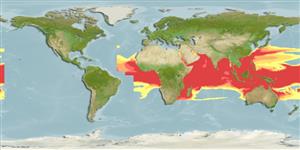>
Beloniformes (Needle fishes) >
Exocoetidae (Flyingfishes)
Etymology: Cheilopogon: Greek, cheilos = lip + Greek, pogon = barbed, beard (Ref. 45335).
Environment: milieu / climate zone / depth range / distribution range
Ökologie
seewasser; ozeanodrom (Ref. 51243); tiefenbereich 0 - ? m. Tropical; 40°N - 30°S
Indo-West Pacific: in tropical waters, south to the Mascarenes, Aldabra, and Natal, South Africa (Ref. 33390) and east to Japan, the Caroline and Solomon islands. Western Atlantic: 40°N to off Rio de Janeiro in Brazil. Eastern Atlantic: Gulf of Guinea and adjacent waters.
Size / Gewicht / Alter
Maturity: Lm ? range ? - ? cm
Max length : 28.0 cm SL Männchen/unbestimmt; (Ref. 3613)
Rückenflossenstacheln (insgesamt): 0; Rückenflossenweichstrahlen (insgesamt): 13-15; Afterflossenstacheln 0; Afterflossenweichstrahlen: 8 - 11. Body dark iridescent blue above, silvery white below; pectorals black with pale margin, central portion crossed by a yellowish stripe becoming narrower toward anterior fin margin; pelvic fins with prominent black spot (Ref. 6797). Body of juveniles with dark bars (Ref. 6797).
Inhabits surface waters of the open ocean, capable of leaping out of the water and gliding for long distances above the surface (Ref. 3395). Planktivore (Ref. 97629).
Life cycle and mating behavior
Geschlechtsreife | Fortpflanzung | Ablaichen | Eier | Fecundity | Larven
Parin, N.V. and R.H. Gibbs Jr., 1990. Exocoetidae. p. 583-591. In J.C. Quero, J.C. Hureau, C. Karrer, A. Post and L. Saldanha (eds.) Check-list of the fishes of the eastern tropical Atlantic (CLOFETA). JNICT, Lisbon; SEI, Paris; and UNESCO, Paris. Vol. 2. (Ref. 4498)
IUCN Rote Liste Status (Ref. 130435)
Bedrohung für Menschen
Harmless
Nutzung durch Menschen
Fischereien: weniger kommerziell
Mehr Information
NamenSynonymeMetabolismusRäuberÖkotoxikologieFortpflanzungGeschlechtsreifeAblaichenSpawning aggregationFecundityEierEientwicklung
ReferenzenAquakulturAquakultur ProfilZuchtlinienGenetikElectrophoresesVererbbarkeitKrankheitenVerarbeitungNutrientsMass conversion
PartnerBilderStamps, Coins Misc.LauteCiguateraGeschwindigkeitSchwimmstilKiemenoberflächeOtolithsGehirngrößeSehfähigkeit
Tools
Zusatzinformationen
Download XML
Internet Quellen
Estimates based on models
Preferred temperature (Ref.
123201): 24.8 - 29.1, mean 28 °C (based on 1460 cells).
Phylogenetic diversity index (Ref.
82804): PD
50 = 0.5000 [Uniqueness, from 0.5 = low to 2.0 = high].
Bayesian length-weight: a=0.00646 (0.00292 - 0.01429), b=3.04 (2.84 - 3.24), in cm total length, based on LWR estimates for this (Sub)family-body shape (Ref.
93245).
Trophic level (Ref.
69278): 3.0 ±0.08 se; based on food items.
Generation time: 0.6 ( na - na) years. Estimated as median ln(3)/K based on 2
growth studies.
Widerstandsfähigkeit (Ref.
120179): hoch, Verdopplung der Population dauert weniger als 15 Monate. (K>1).
Fishing Vulnerability (Ref.
59153): Low vulnerability (16 of 100).
